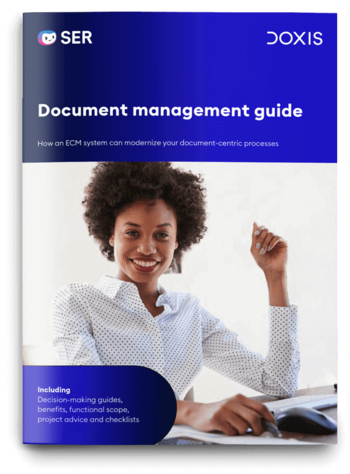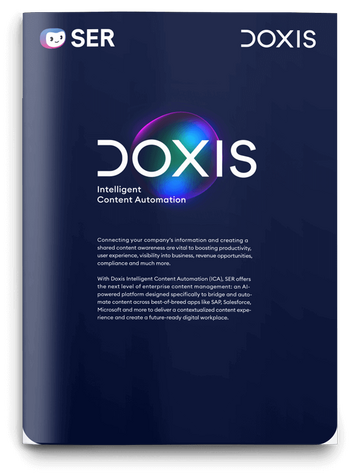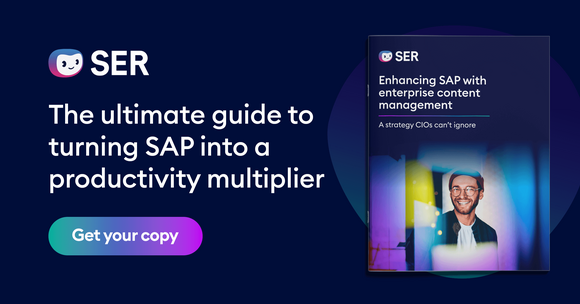SER Blog Customer Stories & Use Cases
Manage project charters like a boss and lead your projects to success
When businesses invest in IT solutions like ERP systems or online shops, they usually have a firm idea of what they want—until the project kicks off and those ideas start shifting like sand in a wind tunnel. That’s where a project charter comes in. It’s a detailed roadmap that keeps everyone on the same page, setting out clear expectations and acting as the foundation for contracts, so no one can claim they "thought it was included" six months down the line.
In this article, you’ll learn what makes up a project charter, how it guides project decisions and how to create and securely manage your own project charter.

What is a project charter?
The project charter—also known as a requirements specification or catalog of requirements—is essentially a wishlist from the customer, but with fewer hopes and dreams and more legally binding expectations. It pulls together all the key requirements for a project or tender process, ensuring there’s a clear, agreed-upon foundation before things start moving.
In practical terms, before a project kicks off, the customer drafts a project charter that lays out exactly what they need. These requirements fall into two categories:
- Non-functional requirements define how the system works.
- Functional requirements define what the system does.
For instance, a non-functional requirement could be that the system needs to encrypt user data, while a functional requirement could be that users can log on to the system by entering the user data.
The project charter is the contractor’s go-to document of framework conditions for a project contract, including all deliverables on the contractor’s side.
Project charter or system specification?
In contrast to the project charter, the system specification describes in much more granular detail how the contractor fulfills the requirements described in the project charter. For instance, it says when the contractor will deliver the system and at what price.
In the case of software, the system specification will usually also include a firm timeline leading up to the delivery date. As the companion document to the project charter, the system specification also constitutes a contractual basis for the joint project.
What purpose does a project charter serve?
As the contractual basis for a joint project, on the one hand the project charter contains all of the customer’s requirements. On the other, it provides clarity for the contractor, stopping mix-ups before they can start.
The benefits:
- The project charter gives the contractor a basis for drafting their bid.
- All contractor deliverables are clearly expressed, preventing miscommunication.
- The contractor can immediately see if the customer’s expectations are achievable.
- Project managers plan their project time lines, processes and milestones based on the project charter.
- Requirements are transparently communicated, reducing the need for feedback loops later on.
Good to know: In rare cases, the project charter does not make it to the contract stage but instead provides a launch point for discussion—e.g., if the contractor advises against certain services in the charter or proposes alternative solutions.

Document management guide
How can a DMS boost your organization’s efficiency? Which system is right for you? This practical guide helps you to find & implement the right DMS. Incl. checklists, real-life examples, etc.
Read nowWhat’s in a project charter?
A project charter is essentially a document that says, “Here’s what we’re doing, why we’re doing it and who’s responsible.” According to DIN 69901-5 (the official project management standard), a project charter follows a specific structure.
Different industries have their own variations. For example, software projects might refer to ANSI/IEEE 29148-2018, which details requirements for software development.
Here’s how a typical project charter is structured:
- Introduction: Includes the purpose of the document, the scope of the software, relevant terms and abbreviations, references to other sources or resources and an overview of the document structure.
- General description of the software: Includes the product perspective, the product functions, user characteristics, information on limitations and influencing factors for developers, as well as how these relate to the different requirements.
- Specific requirements: Includes non-functional and functional requirements, necessary external interfaces, information on design constraints, performance and quality requirements and other customer expectations.
And generally speaking, a project charter should answer the following questions:
- What’s the project about?
- What purpose does the solution serve?
- What form should the solution take?
- What does the contractor need to be aware of?
The importance of the project charter in project management
Project charters set the foundation for a well-organized, successful project. They give project managers a clear roadmap to follow throughout the planning phases, making sure everyone knows what’s happening and when.
A well-crafted project charter is crisp, clear, and packed with essential details—like the official end date and what the final outcome should look like. It keeps things on track, aligns expectations and helps prevent confusion before the real work begins.
The project charter fulfills three important functions for project managers:
- Defined targets: A project charter helps keep both the customer and the contractor aligned with the same goals throughout the project.
- Control: A project charter is the yardstick for measuring progress at all stages of the project.
- Quality assurance: A project charter transparently communicates what the customer expects from the final version.
Use cases: When companies need a project charter
No matter the industry, a project charter is what stops a project from turning into an expensive guessing game. It’s the go-to document for kicking off technical systems, products, applications or infrastructure projects. Here’s how different sectors use them:
- Engineering and construction: For developing a factory production line or planning a production plant.
- Electronics: For developing smartphones and other devices.
- Construction and real estate: For building office blocks or renovating a historic listed building.
- Medical and pharmaceutical: For manufacturing monitoring equipment for diagnostic systems or designing software for managing patient data.
- Automotive: For building new vehicle models or producing batteries.
- Public administrations: For publishing calls for tender for infrastructure services or awarding construction contracts in public spaces.
- Software engineering: For building apps, e-commerce platforms and other web applications, or enterprise software such as ERP or CRM systems.
Create your own software project charter
Planning to commission new software? Write your own project charter! Typically, the system will mesh with an existing IT landscape, so make sure that the project charter includes not only the software requirements, but also the environment in which the software is expected to operate.
For instance, if you use an ERP system, the new software should integrate into the existing IT landscape—so think about the need for any external interfaces or similar. You also need to bear in mind potential licensing issues and include them, too.
Last but not least, the project charter is not about meticulously detailing technical requirements. The overriding goal is that the software optimizes your processes and works as part of your existing landscape. That’s why the contents of your project charter should always be written from a process-centric perspective.
Doxis helps you write and archive project charters
The project charter serves as a guide during the project and as a reference point afterward. It outlines the target software’s functions and original use case, making it easy to check details later.
To keep it accessible, the project charter should be securely stored and available within the company. A document management system (DMS) is the best way to manage project charters through every stage—creation, editing, filing and archiving.
How do I manage project charters in Doxis?
- Create: Create a new “project charter” document in Doxis. If available, you can also use an existing template for project charters where that makes sense for your project.
- File: Assign the “project charter” document to the relevant project. Doxis then files and organizes the project charter in the project eFile.
- Edit: You can now start working on your project charter. In Doxis, multiple users can access the document in parallel. Versioning ensures you always see the latest document version.
- Archive: Once the project charter is finalized, Doxis sends the document for safe-keeping in the audit-proof archive, where it stays available to authorized users but is protected against any further changes.
Good to know: Don’t worry if you created your project charter on paper or outside of Doxis—simply upload it to Doxis later on. For paper documents, use substitute scanning to replace the hard copy with the digital version.

Doxis Intelligent Content Automation
With Doxis Intelligent Content Automation SER offers the next level of enterprise content management.
Read nowSecurity for both sides
A project charter puts the collaboration on a firm footing for customer and contractor alike. Both sides know the target outcome from the get-go. Project managers are guided by the project charter from start to finish, to safeguard the rights and obligations of all stakeholders. Companies are free to choose the structure of their project charter.
Guidance on content is available in the form of the DIN 69901-5 standard and other industry-specific requirements. But one thing is clear: the project charter determines whether or not an order is fulfilled. In Doxis, your project charters and other documents are saved securely and accessibly for the long haul.
Want to learn more? Reach out for a free, no-obligation demo on how Doxis can streamline your project charter workflows.
FAQs on project charters
The latest digitization trends, laws and guidelines, and helpful tips straight to your inbox: Subscribe to our newsletter.
How can we help you?
+49 (0) 30 498582-0Your message has reached us!
We appreciate your interest and will get back to you shortly.




